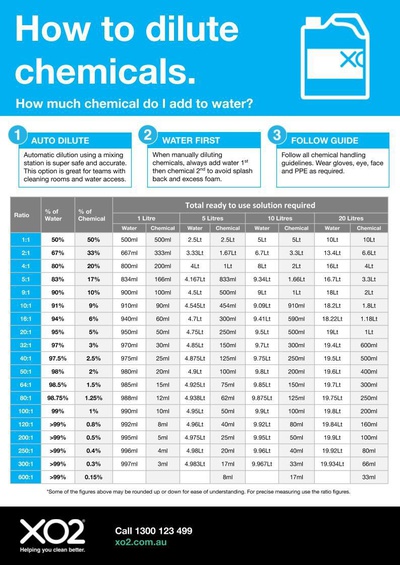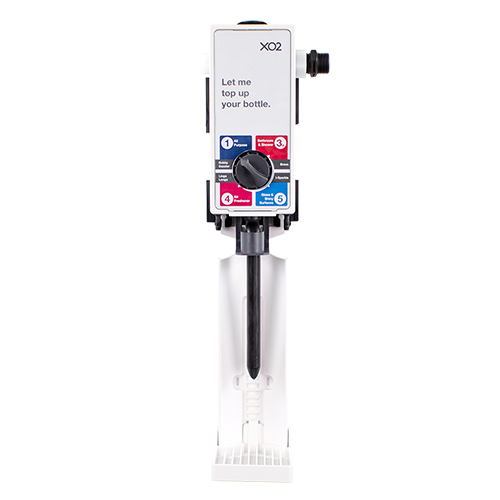Read time: 5 minutes
Working out the dilution rate for concentrated commercial cleaning chemicals can be difficult. Regardless of your industry, whether your in healthcare, education, facility maintenance, hospitality or professional cleaning, correctly and accurately diluting cleaning chemicals with water is a skill that must be mastered.
Let's jump right into a dilution example...
OK, so the label says 32:1 but how much water and how much cleaning chemical concentrate do you put in the bottle, bucket or cleaning machine tank?
It’s important to get this right so let’s talk about a quick and easy way to calculate how much chemical you will need for any dilution rate.
Concentrated cleaning products will save you lots of money provided you know how to safely and accurately mix them with water.
Time to get started...
The dilution rate is usually indicated as a ratio of chemical to water, for example 1:32. In this example it means the ideal dilution ratio of the product is 1 part chemical concentrate to 32 parts water…
Here's how you can work out exactly how much you will need in your sized bottle, bucket or tank?
Step 1. How much ready to use solution do you need?
Are you filling a bottle or a bucket or a tank?
Do you need 750ml? 6 litres? 50 litres?
Let’s take an example of a bucket... It’s an 11 litre bucket but you only want to fill it to just over half way, so let’s say we need 6 litres in total of cleaning solution. That’s the ready to use solution you need.
Step 2. What is the recommended chemical concentrate dilution rate?
Select the dilution rate that is appropriate for your task. You can look on the label or for more details check out the product’s training information guide for more details.
Let’s continue with the example of the bucket that holds 6 litres of ready to use solution.
Now, if the chemical dilution rate you have selected is 1:32 (this may sometimes be written as 32:1) how much water first needs to be added to the bucket and then how much chemical concentrate will you need?
Step 3. Let’s calculate exactly how much water and chemical you will need.
Here is where the rubber meets the road and a little bit of simple maths is required.
Let’s continue with the example of the 11 litre bucket which you want to fill with 6 litres of ready to use cleaning solution.
Here goes…
a. Total amount of 'Ready to Use' or RTU cleaning chemical solution required is...
6 litres or 6000ml
b. Recommended dilution rate is...
1:32 or 32:1. That’s 33 parts… 1 part of chemical and 32 parts of water. It’s important that you always add the 2 dilution ratio numbers together for the calculation below!
c. Ready for some magical cleaning chemical dilution maths?
Divide the total amount of solution required (1. 6L or 6000ml) by... the total number of dilution ratio parts (33) and that will equal how much cleaning chemical you need in your bucket.
d. The maths looks like this....
6L or 6000ml / (divided by) 33 parts = (equals) 0.182L or 182ml of cleaning chemical concentrate.
The final answer...
You will need 182ml of cleaning chemical concentrate in a bucket that you want 6L of solution in.
So that’s 5.818L / 5818ml of water and 182ml of cleaning chemical.
Easy isn’t it?
It will take some practice, most mobile phones these days have a calculator that will make your calculation even easier.

Remember safety when diluting cleaning chemical concentrates.
We won’t go over safety again here completely but remember to add water first to your bottle, bucket or tank and then the cleaning chemical concentrate to avoid any splashes of concentrate. Also, wear gloves, goggles and other personal protection equipment (PPE) when required.
Pro Tip
If you’re filling the same bucket, bottle or machine tank every time...
and you always use the same dilution rate with the same amount of solution...
why not make some marks using a permanent marker so you know how far to fill with water and how much further you should fill with your cleaning chemical concentrate.
If it sounds too hard don’t worry. Here’s 4 even easier workarounds…
1. Use XO2 cleaning chemical concentrates.
The labels have all the dilution info you need. Our labels and training information guides do this calculation for you. XO2 not only lists dilution rates but also how many millilitres (mls) of concentrate you need per litre of ready to use solution.
2. Free quick reference 'How to dilute chemicals' chart
Check out free cleaning chemical dilution rate cheat sheet for an even easier way to work out how much cleaning chemical concentrate you need to add. You are welcome to click on the image below, print it out and use it in your business for FREE. Best to laminate it first because it might get splashed from time to time.
3. Automatic Chemical Dosing & Dilution Dispensers
Use a cleaning chemical dilution dispenser like that has a pre-set dilution tip that does the work for you.
4. Download a mobile phone chemical dilution app
Find an app on the Google Play Store or Apple App Store for your mobile phone that will work it out chemical dilutions for you.
We hope this information has helped you.
Feel free to call our customer care team on 1300 123 499, if you require any help or advice on cleaning chemical concentrate dilution.
If you’re interested in learning more about XO2’s range of professional and eco-friendly cleaning chemical concentrates, you can visit the cleaning chemicals here.
Have a great day everyone!
Related articles
- How To Calculate A Parts Per Million (ppm) Solution Of Sodium Hypochlorite (Hypo, Chlorine) Into A Simple Dilution Rate
- 11 Essential Things For a Facility Cleaning Supplies Storeroom
- How To Set Up a Cleaning Chemical Register
- 21 Cleaning Chemical Handling Guidelines For Your Workplace
- 17 Disinfectant Safety Tips Everyone Should Know
- Why Wearing Disposable Gloves Is Dangerous
- Colour Coding And Better Hygiene For The Cleaning Industry
- The 6 Commandments For Handling Cleaning Chemicals
- How To Prevent Injuries Caused by Slips Trips And Falls
- Everything You Need To Know About pH And Cleaning Chemicals
- The 5 Steps To Safety Success In Your Facility's Cleaning & Hygiene Department
- The 3 Best Places To Get Cleaning Chemical Safety Information

